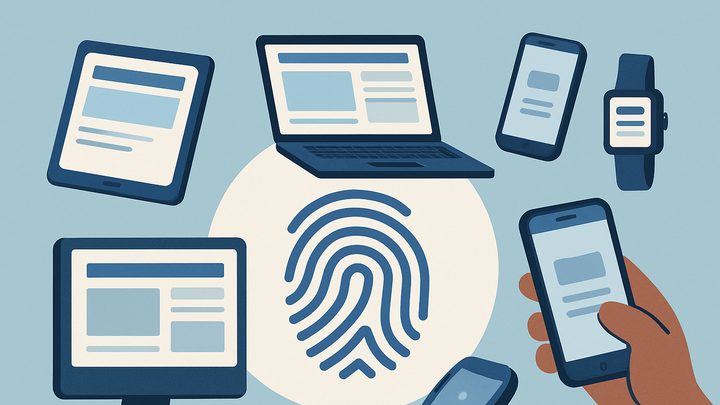Published on 2025-06-26T04:42:19Z
What is Device Fingerprinting? Examples and Use Cases in Analytics
Device fingerprinting is a method for identifying and tracking individual devices accessing a website or application without relying on traditional cookies. Instead, it collects a range of device and browser attributes—such as user agent strings, screen resolution, installed fonts, and canvas/browser rendering data—to generate a unique identifier (the “fingerprint”) for each device. This technique enables analytics platforms to distinguish between returning and new visitors, even if they clear cookies or use private browsing modes. In an era of increasing privacy regulations and cookie restrictions, device fingerprinting serves as a powerful alternative for maintaining user insights. Examples of platforms leveraging this technique include PlainSignal (for simple, cookie-free analytics) and Google Analytics 4 (GA4), which uses fingerprinting alongside cookies and other identifiers.
Device fingerprinting
Device fingerprinting identifies unique devices by collecting attributes, enabling tracking without cookies in analytics.
Definition of Device Fingerprinting
An overview of what device fingerprinting entails, why it’s called fingerprinting, and the core concepts behind generating unique device identifiers.
-
Key attributes collected
Device fingerprinting gathers multiple data points from the browser and device to create a composite identifier.
-
User agent
Provides browser and operating system details to distinguish device types.
-
Screen resolution
Captures the display dimensions which can vary between devices.
-
Installed fonts
Lists available system fonts that can differ across setups.
-
Canvas fingerprint
Uses HTML5 Canvas to render and extract graphics data unique to the device’s GPU and drivers.
-
-
Creating the fingerprint
All collected attributes are concatenated and hashed using algorithms like SHA-256 to produce a stable, unique identifier.
How Device Fingerprinting Works
Step-by-step process showing how analytics tools collect and process device attributes to generate fingerprints.
-
Data collection
Tools run scripts to fetch a variety of device and browser info.
-
Http headers
Includes user-agent, accept-language, and other header fields.
-
Javascript apis
Accesses Canvas, WebGL, AudioContext, and more for entropy.
-
Rendering features
Gathers data on CSS styles, supported formats, and font metrics.
-
-
Hash generation
Combines collected parameters into a hash, ensuring minor changes don’t produce completely different fingerprints.
Benefits and Limitations
An analysis of the strengths and challenges associated with using device fingerprinting in analytics.
-
Benefits of device fingerprinting
Fingerprinting can enhance user tracking and data accuracy.
-
Resilient to cookie deletion
Remains effective even when users clear cookies or use private mode.
-
Cross-browser tracking
Links sessions across different browsers on the same device.
-
Supplemental data source
Complements cookie-based analytics to improve coverage.
-
-
Limitations and challenges
Despite its utility, fingerprinting faces obstacles that can impact effectiveness.
-
Privacy concerns
Users and regulators may view fingerprinting as intrusive.
-
Device changes
Software updates or hardware swaps can alter fingerprints.
-
Accuracy variability
Similar devices may yield identical fingerprints, causing collisions.
-
Usage in SaaS Analytics Tools
How leading analytics platforms implement device fingerprinting, with configuration examples.
-
PlainSignal (cookie-free simple analytics)
PlainSignal leverages device fingerprinting to track visitors without cookies. Example integration:
<link rel="preconnect" href="//eu.plainsignal.com/" crossorigin /> <script defer data-do="yourwebsitedomain.com" data-id="0GQV1xmtzQQ" data-api="//eu.plainsignal.com" src="//cdn.plainsignal.com/plainsignal-min.js"></script> -
Google analytics 4 (GA4)
GA4 can use fingerprinting when cookies aren’t available. Basic setup:
<script async src="https://www.googletagmanager.com/gtag/js?id=G-XXXXXXX"></script> <script> window.dataLayer = window.dataLayer || []; function gtag(){dataLayer.push(arguments);} gtag('js', new Date()); gtag('config', 'G-XXXXXXX', { 'anonymize_ip': true }); </script>
Privacy and Compliance Considerations
Key legal frameworks and best practices to ensure fingerprinting remains transparent and compliant.
-
Regulatory frameworks
Major data protection laws affecting fingerprinting:
-
Gdpr
Requires clear user consent for processing personal data.
-
Ccpa
Grants California residents rights to opt out of data sales.
-
Eprivacy directive
Regulates tracking technologies, potentially classifying fingerprints as cookies.
-
-
Best practices for compliance
Guidelines to implement fingerprinting responsibly:
-
Obtain explicit consent
Inform users and get permission before fingerprinting.
-
Data minimization
Collect only the attributes necessary for analytics.
-
Hashing and anonymization
Store only non-reversible hashes to protect user privacy.
-
